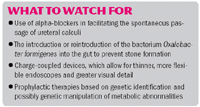Article
Medical therapy will play larger role in stone disease
This special issue takes an up-close look at what’s new, and what’s coming, in key areas of clinical urology. UT’s board members share their expert views on what to expect at this month’s AUA annual meeting and beyond.
Glenn M. Preminger, MD, professor of urologic surgery at Duke University Medical Center, Durham, NC, sees four significant advances in treating stone disease approaching and anticipates reports on each topic at the upcoming AUA annual meeting.
Medical therapies have been developed and tested to facilitate the spontaneous passage of ureteral stones; medical and dietary programs are being established to prevent nephrolithiasis; significant advances that will facilitate the minimally invasive removal of stones are being made in endoscopic equipment; and technological ad-vances in shockwave lithotripsy will improve stone fragmentation while at the same time minimize trauma to renal tissue.

He noted that one of the more novel approaches to stone prevention involves the introduction or reintroduction of the bacterium Oxalobacter formigenes into the gut. The bacteria, which degrades oxalate, routinely colonizes in the gut of children but may be absent in many adults. This bacterium may be wiped out by antibiotic treatment. Its absence may be a risk factor for stone formation.
The reintroduction of this bacteria may reduce stone formation, said Dr. Preminger, who expects to see presentations on this approach at the meeting.
Endoscopic advances One of the technological advances in endoscopic surgery has placed charge-coupled devices (CCDs) at the tip of the endoscope. CCDs convert light directly to digital information for transmission to video. This advance effectively puts the camera at the tip of the endoscope and allows for thinner, more flexible endoscopes while at the same time presenting more detail.
"Any enhancements of imaging technologies, endoscopes, stents, and fragmentation devices are all going to reduce the morbidity associated with percutaneous or ureteroscopic management of symptomatic stones," he said.
"There are also going to be several studies of enhanced fragmentation technologies. Holmium lasers as well as pneumatic lithotripters have been improved, and there should be new information on these advancing technologies," he added.
In addition, look for new concepts in ureteral stenting.
"The idea of coating ureteral stents with antimicrobials and other compounds has been around for several years and may be reaching fruition," Dr. Preminger said. "When you look back over the last 5 years, there are many who would argue that research in shockwave lithotripsy has stagnated, as there appeared to be greater emphasis on improvements in endourology. The pendulum may swing back toward SWL if some of these newer lithotripsy technologies come to fruition."
Looking further into the future, Dr. Preminger foresees the arrival of therapies based on genetics.
"We are going to see more effective prophylactic therapies evolving that will be based on genetic identification and perhaps genetic manipulation of metabolic abnormalities," he said.
He added that new minimally invasive technologies with significant potential for removing symptomatic calculi with reduced patient morbidity are on the horizon.
"Anything we can do to remove stones more quickly and more safely is not only going to improve the immediate care of the patient but is also going to reduce costs. Advances in prophylactic metabolic stone therapy may have an even greater impact on costs, by keeping patients out of the operating room," he concluded.
Newsletter
Stay current with the latest urology news and practice-changing insights — sign up now for the essential updates every urologist needs.















